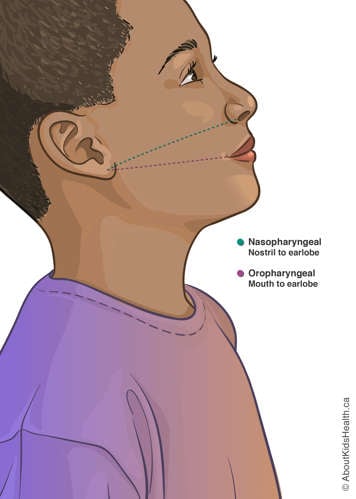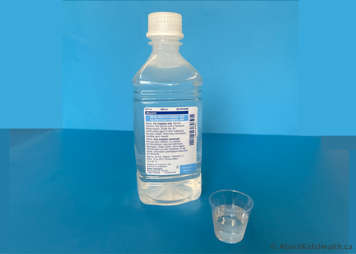
At the end of this chapter, you will be able to:
- understand when to perform oropharyngeal suctioning
- demonstrate how to perform oropharyngeal suctioning
Oropharyngeal (through the mouth) suctioning is done to clear secretions (mucus) from the throat if a child is unable to cough them up or swallow them. A hard plastic tip with a handle called a Yankauer or a catheter is usually used to suction secretions in the mouth.

The illustration to the right shows how to correctly measure and verify the length to which you will suction (measure catheter from the mouth to the tip of earlobe for oropharyngeal suctioning. Your child’s health-care team will teach you this.
-

Gather your equipment and supplies.
-

Make sure the oximeter oximeter is on and providing an accurate reading.
Have oxygen available, if prescribed for your child.
-

Make sure the suction machine is at the correct setting.
-

Wash your hands well. Parents and caregivers do not need to wear gloves, although you may choose to do so if you have them. If you have a home nurse visiting, they will bring their own gloves and wear them.
-

Fill a clean container with sterile water or saline.
-

Make sure your child is in a comfortable position (lying or sitting).
-

Attach the suction tubing to the correct size suction catheter. Keep the catheter in the packaging until just before use.
-

Do not touch the end of the catheter that will go further back into the back of your child’s mouth.
-

If you have not yet measured the suctioning distance, do it once the catheter is out of the packaging, just before you insert the catheter into the mouth to suction. The catheter should be measured from the corner of the mouth to the earlobe, as pictured here.
-

Insert the suction catheter into your child’s mouth to the length instructed by your child’s health-care team. The catheter should be aimed along the sides of the mouth. Be careful not to force the catheter. If you meet resistance, reposition, and try again gently.
Please suction only to the depth prescribed by your child’s health-care provider. Do not go deeper.
-



Apply suction by holding your thumb over the suction control port. Slowly remove the catheter. Limit suctioning to 5 to 10 seconds.
-

Rinse catheter to clean if needed. Repeat suctioning as needed, allowing at least 30 seconds between suctioning. Once you are finished, rinse sterile water or saline through the catheter to flush the tubing well. Discard the catheter and water that was poured.
-

After suctioning, assess your child’s respiratory status and oxygen needs.
Turn off the suction unit. Empty and clean the suction drainage bottles and containers, if needed.
Wash hands well.
Prepare the suction equipment and supplies for the next use.
Precautions
Do not perform oropharyngeal suctioning if:
- your child has had recent nose, sinus or throat surgery
- your child has a bleeding disorder
| Suction catheter size: | |
| Depth of suction catheter insertion for oropharyngeal suctioning: | |
| Suction machine pressure setting (mmHg): |